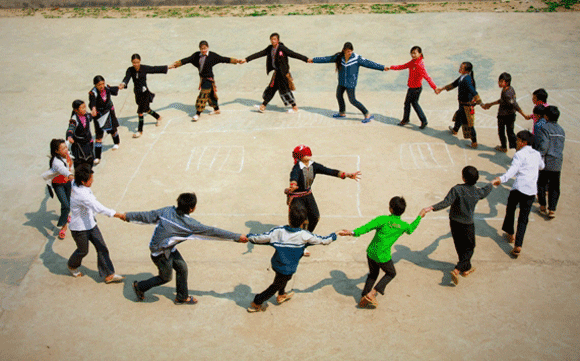Folk games stem from humans working and practicing their religious activities. Each of Vietnam’s 54 ethnic groups have their own folk games.
The Kinh group are famous for various folk games, including the game of dragon and snake, the game of squares, blind man’s bluff, wrestling, and rock, paper, and scissors.
Other groups have many folk games like xoe dancing, sticky rice cake pounding, tug of war, walking on stilts, and crossbow shooting.
Most of these games are played during festivals and important occasions. They require the participation of many people, and challenge both their minds and physical abilities.
Folk games for children and those played at festivals are a bit different. Those played at festivals often represent a myth or are in praise of particular Genies and fairies while those for children are purely for entertainment. Children set their own rules for the games and change them as they wish.
“I like all Vietnamese folk games, especially the game of squares, rope jumping, shuttle cock kicking, and cotton ball throwing. I feel relaxed playing such games, especially after hours of intense studying,” Nguyen Nhu Bao Uyen of Hanoi’s Dong Da secondary school told VOV.
Many folk games are fading away due to social changes, technological development, urbanization and modernization. Many children now prefer computer games and online entertainment to traditional games.
“We need more appropriate solutions and management ways from concerned agencies to preserve our many folk games. Games are inseparable parts of childhood. Children can play games at schoolyards or at common grounds of their residential areas. Folk games should be brought to each family. Parents are advised to spend their time, about half an hour, to teach their children to play folk games,” said Doctor Tran Huu Son, Deputy Chairman of Vietnam Folklore Arts Association.
“By introducing folk games at home, at schools, at residential areas, common places, and even online, it’s possible to get children interested in such games,” he added.
More attention has been given to revitalizing folk games over the years. Folk games are being introduced more at museums, cultural houses, children palaces and clubs, schools, and festivals. Businesses specializing in producing traditional games for children have seen initial success.
“In addition to entertainment benefits, folk games also help players improve their mind sharpness and physical conditions. They create wonderful opportunities for children to have fun time with their friends from neighbors and schools,” said Chu Tien Dat of Hanoi.




